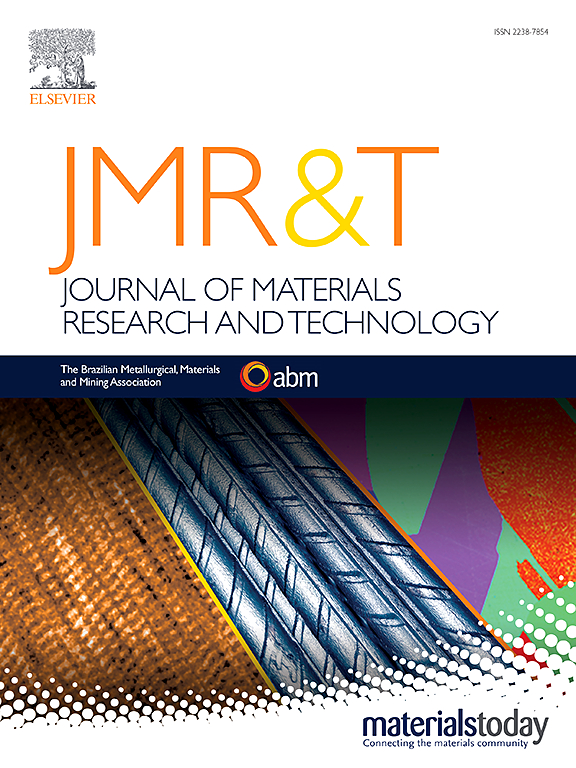新型铜-层间Ti-6Al-4V线增强铝基复合材料界面特性及强化机理
IF 6.6
2区 材料科学
Q1 MATERIALS SCIENCE, MULTIDISCIPLINARY
Journal of Materials Research and Technology-Jmr&t
Pub Date : 2025-06-13
DOI:10.1016/j.jmrt.2025.06.088
引用次数: 0
摘要
5xxx系列铝合金具有优良的可焊性和耐腐蚀性,在工业上得到广泛应用。然而,与2xxx (410-510 MPa)和7xxx系列合金(570-690 MPa)相比,它们的抗拉强度(240-400 MPa)相对较低,限制了它们在高应力环境中的应用。针对5052铝合金力学性能的局限性,采用镀铜、梯度热加工和热浸模铸造相结合的方法制备了铜层间Ti-6Al-4V线增强铝基复合材料(Cu-TC4/AMC)。定量分析表明,Cu-TC4/AMC在860℃处理45 min后,强度分别比铝基复合材料和常规复合材料提高了91.9%和22.6%。铜缓冲层通过动力学屏障效应抑制Al-Ti相互扩散,并由于其延展性而重新分配应力,从而显著改变界面演化。通过控制电沉积和非等温烧结实现的多尺度界面设计,解决了钛铝系统中增强效率和界面脆化之间长期存在的权衡。这些发现得到了x射线衍射和EBSD分析的支持。这项工作展示了一种平衡铝基复合材料强度和延展性的创新策略,为高性能结构材料的界面设计提供了新的见解。本文章由计算机程序翻译,如有差异,请以英文原文为准。
Interfacial characteristics and strengthening mechanisms of novel copper-interlayered Ti-6Al-4V wire-reinforced aluminum matrix composites
The 5xxx series aluminum alloys are widely used in industry due to their excellent weldability and corrosion resistance. However, their relatively low tensile strength (240–400 MPa), compared to 2xxx (410–510 MPa) and 7xxx series alloys (570–690 MPa), restricts their application in high-stress environments. To address the mechanical property limitations of 5052 aluminum alloy, a novel strategy combining copper electroplating, gradient thermal processing, and hot-dip metal mold casting was developed to fabricate copper-interlayered Ti-6Al-4V wire-reinforced aluminum matrix composites (Cu-TC4/AMC). Quantitative analysis shows that Cu-TC4/AMC treated at 860 °C for 45 min exhibits a 91.9 % and 22.6 % increase in strength compared to the aluminum matrix and conventional composites, respectively. The copper buffer layer significantly alters interfacial evolution by suppressing Al-Ti interdiffusion through a kinetic barrier effect and redistributing stress due to its ductility. The multiscale interfacial design, achieved through controlled electrodeposition and non-isothermal sintering, addresses the longstanding trade-off between reinforcement efficiency and interfacial embrittlement in titanium-aluminum systems. These findings are supported by X-ray diffraction and EBSD analysis. This work demonstrates an innovative strategy for balancing strength and ductility in aluminum matrix composites, offering new insights into interfacial design for high-performance structural materials.
求助全文
通过发布文献求助,成功后即可免费获取论文全文。
去求助
来源期刊

Journal of Materials Research and Technology-Jmr&t
Materials Science-Metals and Alloys
CiteScore
8.80
自引率
9.40%
发文量
1877
审稿时长
35 days
期刊介绍:
The Journal of Materials Research and Technology is a publication of ABM - Brazilian Metallurgical, Materials and Mining Association - and publishes four issues per year also with a free version online (www.jmrt.com.br). The journal provides an international medium for the publication of theoretical and experimental studies related to Metallurgy, Materials and Minerals research and technology. Appropriate submissions to the Journal of Materials Research and Technology should include scientific and/or engineering factors which affect processes and products in the Metallurgy, Materials and Mining areas.
 求助内容:
求助内容: 应助结果提醒方式:
应助结果提醒方式:


